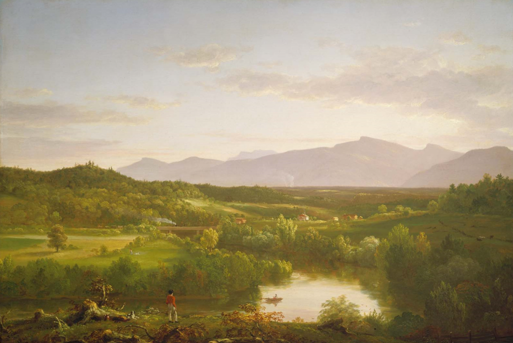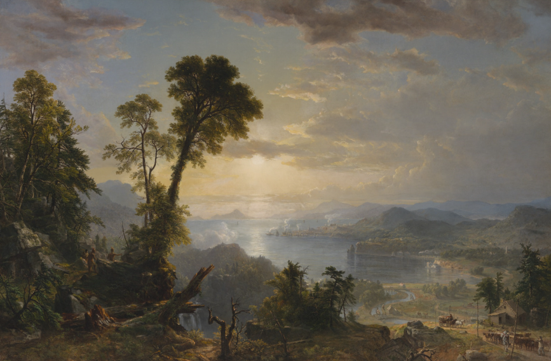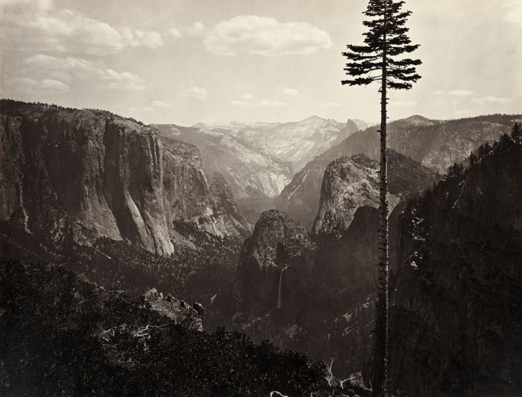Lecture 14: ‘Contemporary Issues in American Landscape Art’
1/9
There's no tags or description
Looks like no tags are added yet.
Name | Mastery | Learn | Test | Matching | Spaced |
|---|
No study sessions yet.
10 Terms
Key Ideas
The canonical landscape paintings of 19th century America have conventionally been read as neutral documentation
BUT tacit white perspective written into these landscapes
The American landscape tradition has become a potent basis for critique for contemporary artists & contemporary historians of American art
w/ relation to other contemporary issues (e.g. histories of settler colonialism; the current environmental crisis)
The Landscape Tradition in America
Time period
Key ideals/iconography (2)
Significance (2)
Time period
19th century
Newly-formed United States (founded in late 18th century)
Key ideals/iconography
The sublime in nature
Untouched wilderness
Significance
Was identified as the 1st national school of painting in the US
Shaped American national identity
Landscape tradition fit w/ an emergent pride of place
Among the 1st popular expressions of cultural nationalism
Hudson River School
Historical context
Characteristics (3)
Historical context
‘School’ = school of thought
19th century
America’s 1st artistic fraternity
Characteristics
Socially similar
All white men (some immigrants, but all lived in NYC)
Stylistically similar, shared approach to painting
Imbued the landscape w/ a narrative & moral weight
Shared mindset
America as a new world/Eden
Idea that America was a previously untouched wilderness
Merged ideas of nature & nation
Painting as a source of patriotic pride
Evolution of the American Landscape Tradition
Time period
Stages of development (3)
Time period
1820s to late 1800s
BUT not always discrete (e.g. can have multiple themes in a single painting)
Stages of development
Critical romanticism
Imagined wilderness in opposition to modern industrial life
As 2 sides of the same coin
Art used to depict:
Expression of emotion
Human psychology/personal feeling
Drama of the natural world
E.g. River in Catskills, Thomas Cole (1843)
Middle landscape
Envisioned a future in which nature & industry could be sustained in balance
Reconciled OR at the very least held in balance in a way that’s stable & sustainable
Deliberate exclusion of Indigenous Americans
Who were actually the ancestral stewards of the lands depicted
This positioning is used as both an allegory for development AND a political position promoted through landscape paintings ⭐
E.g. The Oxbow, Thomas Cole (1836)
Preservationism
Promoted ideal of federal protection for undeveloped nature (and/or ignored the reality that this balance was tipping towards human settlement)
E.g. The Hayden Survey (1871)

Historical context (3)
Analysis
Interpretation (2)
River in Catskills (1843), Thomas Cole
Historical context
Later painting - has seen the progress of industrialisation
The 1st painted depiction of a locomotive in American tradition
Cole moved to the Catskills in 1836
This was the landscape that he based his career on & was deeply connected with
BUT saw significant changes in development & logging
Loss of wild spaces that he valued
Analysis
Close narrative foreground
Human figure standing amid tree stumps
Holding an axe himself
Bright red coat = clearly differentiated from his natural environment
Deep vista into the distance
Pastoral ideal
Middle ground: little smokestack from a passing locomotive
Interpretation
Critical Romanticism
More ambivalent about the progress of industrialisation
Questioning the human r/s to landscape
Causal r/s between development, deforestation, and humans
Expresses trepidation about the virtue of industrial development
The Hayden Survey
Historical context (time period, goals, participation)
The usage of photography (2)
The distribution of photography
Historical context
1871
Federally-funded geological survey exploring the region of northwestern Wyoming
Involved:
Artists
Photographers
Geologists
Scientists
Goals:
(1) To preserve land for recreational benefit
(2) To map a route for the transcontinental railroad & setting up a specific spur
(3) Ulterior motive of disrupting the natural migratory patterns of buffalo
The indigenous Plains communities relied on these buffalo to sustain their ways of life
= to displace Indigenous people from the land
The usage of photography
Depiction of seemingly neutral & unpopulated landscapes
BUT were actually embedded within the cultural priorities & values of the white individuals who made them
Structured tacitly around modelling a specific way to look at the American landscape
White cultural assumptions that overlaid, obscured & erased centuries of prior inhabitation by Indigenous Americans ⭐
To:
(1) Facilitate a view of the US that naturalised European Americans & their perspective of nature
E.g. The Yosemite Valley from the Best General View, Carleton Watkins (ca. 1865/66)
(2) Make the environment feel uninhabited, accessible, & friendly
E.g. using human figures in photos to demonstrate their massive scale
= to encourage people on the East Coast to move westward & settle in these landscapes
The distribution of photography
Marketing wilderness to tourists (eco tourism)
Photography as a commercial advertisement for experience in place
Showing places & views that needed to be experienced directly
E.g. reproductions in stenographic forms, paintings
E.g. guidebooks
E.g. special viewers
= immersive & 3-dimensional

Visual analysis (2)
Interpretation (4)
Progress (The Advance of Civilisation) (1853), Asher Durand
Visual analysis
Dramatises the meeting of nature & civilisation as we move farther into the distance
Foreground begins in lower right
We follow a literal path of progress
E.g. pioneers w/ ox carts & hay wagons leave a small town w/ a single log cabin
Along the way, technology increases in sophistication
E.g. steamships are in a port exchanging goods in a global marketplace
= industrial development as harmless, if not inevitable
Exclusion of Indigenous Americans from a picture of progress
3 native figures in the foreground
Entirely disconnected from even the beginning point of the advance of civilisation
Denied access
In the darkest area most shrouded from sunlight
= as if this portion of American identity is at its end, in order for the progress of Euro Americans to proceed forward
Interpretation
Middle Landscape
NOT just a landscape but a moralised narrative
Allegorical celebration of progressive industrialisation
Pictures a world in which nature & industry could be uncompromisingly sustained & balanced w/ one another
Indigenous Americans are NOT a part of the future he envisions

Related reading
Historical context
Analysis
Interpretation (3)
The Yosemite Valley from the Best General View (ca. 1865/66), Carleton Watkins
discussed in Martin A. Berger, ‘Overexposed: Whiteness and the Landscape Photography of Carleton Watkins’
Historical context
Named the ‘best general view’ because it captured ALL the major geologic features of Yosemite Valley in a single photographic composition
Original Indigenous people who inhabited the area were the Paiute & Sierra Miwok
Were driven out of Yosemite by US federal troops in 1851
Visual analysis
Seemingly neutral & unpopulated landscape
Captures distinctive geological features
Monumental, anthropomorphic, commemorative understanding of the landscape
E.g. honouring military leaders (El Capitan), culturally-significant pieces of clothing (‘bridal veil falls’)
Vs. Indigenous names
Descriptive, relational, ecological
Were more likely to note:
The locations of specific plants & animals
The sources of seasonal activities in specific regions (e.g. where hunting & resources could be found)
Some were preserved, BUT these were not visible in the photograph
= what was important to European settlers was overlaying & replacing centuries of prior inhabitation
The few recorded were NOT recorded in connection w/ their actual definition
E.g. we know that Kai-al’-a-wa refers to some cliffs between El Capitan & Half Dome, what the name meant to the Miwok people was not recorded
Interpretation
Preservationism
Photograph is embedded within cultural priorities & values of the white individuals who made them
Embedded w/ white cultural assumptions that overlay, obscure & erase centuries of prior inhabitation by Indigenous Americans
Dissemination of such images helped cultural erasure AND encouraged more settlers from the East to move Westward
Indigenous systems of knowledge were laid upon the land
BUT weren’t necessarily saved/preserved in reliable ways

Historical context (2)
Analysis (3)
Interpretation (5)
View from Mount Holyoke, Northampton, Massachusetts, after a Thunderstorm/The Oxbow (1836), Thomas Cole
Historical context
Oxbow lake
Unusual river feature: bends sharply onto itself
Resembles the yoke that goes over an ox’s neck
Cole responded directly to English prototypes/compositions
Sketched/studied an illustration by Basil Hall, British naval officer
Published Forty Etchings from Sketches made with the Camera Lucida in North America (1827) after his travels in the US
Criticised American artists for not making better use of the landscape
Analysis
2-part compositional structure
Left: dark side of raging wilderness
Departing, violent thunderstorm
Right: sweeping view of pastoral settlement
Sun shining gently
Plantations, buildings puffing with smoke
Contrast emphasises the future possibilities of the nation & landscape
Possibility of hebrew letters inscribed directly into the landscape
Right side up, ‘human’ perspective: Noah
= the land as a promised land after the flood, given to Americans
Upside down, ‘god’s’ perspective: shaddai = Almighty
= divine presence in American land
Given Cole’s investment in spirituality & landscape painting, not impossible
Tiny self-portrait on the wild (left) side of the painting
Set up for one of his sketching trips
Little parasol & sketchbook
Gazing at the landscape
The artist as:
(1) Witness to wilderness
(2) Intrepid, braving the climb to create this work
Interpretation
Middle Landscape
NOT just to scientifcally document the landscape but to capture visual experience
Sense of BALANCE between settled nature & the wilderness
Sublimated the narrative structure within the landscape form
Abandoned recognisable narrative
Combined the sublime w/ the pastoral in a single view (‘union of the picturesque, the sublime, and the magnificent’)
Believed that spiritual awakening could be found in wild places
Just as prophets & saints sought enlightenment in nature, solace could be found in industrial times by retreating into the American wilderness
‘The american wilderness is yet a fitting place to speak to God’
A place he thought religious communion was still possible
In a Western religious context

Historical context
Analysis (2)
Interpretation (1)
Thom, Where Are the Pocumtucks (The Oxbow) (2020), Kay WalkingStick
Historical context
Responds directly to Cole’s earlier The Oxbow
Kay WalkingStick is an indigenous artist
Analysis
Removed Cole’s self-portrait
= removed evidence of Euro-American settlement
Included geometric design over the landscape
From the Nipmucs
Were the original inhabitants of the valley
NOT included in Cole’s depiction
Interpretation
Offers a corrective to art historical erasures that have happened in the past WITHOUT repeating the same wrong/violence
Restores visibility to those who were left out in the original version of the work
Seeks kinship w/ other artists who have found inspiration in American landscapes, BUT centres her own perspective as an indigenous artist